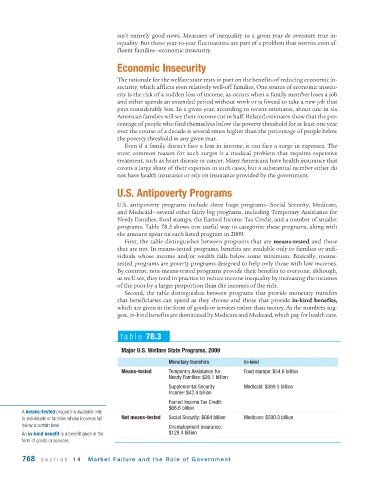Page 810 - Krugmans Economics for AP Text Book_Neat
P. 810
isn’t entirely good news. Measures of inequality in a given year do overstate true in-
equality. But those year-to-year fluctuations are part of a problem that worries even af-
fluent families—economic insecurity.
Economic Insecurity
The rationale for the welfare state rests in part on the benefits of reducing economic in-
security, which afflicts even relatively well-off families. One source of economic insecu-
rity is the risk of a sudden loss of income, as occurs when a family member loses a job
and either spends an extended period without work or is forced to take a new job that
pays considerably less. In a given year, according to recent estimates, about one in six
American families will see their income cut in half. Related estimates show that the per-
centage of people who find themselves below the poverty threshold for at least one year
over the course of a decade is several times higher than the percentage of people below
the poverty threshold in any given year.
Even if a family doesn’t face a loss in income, it can face a surge in expenses. The
most common reason for such surges is a medical problem that requires expensive
treatment, such as heart disease or cancer. Many Americans have health insurance that
covers a large share of their expenses in such cases, but a substantial number either do
not have health insurance or rely on insurance provided by the government.
U.S. Antipoverty Programs
U.S. antipoverty programs include three huge programs—Social Security, Medicare,
and Medicaid—several other fairly big programs, including Temporary Assistance for
Needy Families, food stamps, the Earned Income Tax Credit, and a number of smaller
programs. Table 78.3 shows one useful way to categorize these programs, along with
the amount spent on each listed program in 2009.
First, the table distinguishes between programs that are means-tested and those
that are not. In means-tested programs, benefits are available only to families or indi-
viduals whose income and/or wealth falls below some minimum. Basically, means-
tested programs are poverty programs designed to help only those with low incomes.
By contrast, non-means-tested programs provide their benefits to everyone, although,
as we’ll see, they tend in practice to reduce income inequality by increasing the incomes
of the poor by a larger proportion than the incomes of the rich.
Second, the table distinguishes between programs that provide monetary transfers
that beneficiaries can spend as they choose and those that provide in-kind benefits,
which are given in the form of goods or services rather than money. As the numbers sug-
gest, in-kind benefits are dominated by Medicare and Medicaid, which pay for health care.
table 78.3
Major U.S. Welfare State Programs, 2009
Monetary transfers In - kind
Means - tested Temporary Assistance for Food stamps: $54.6 billion
Needy Families: $20.1 billion
Supplemental Security Medicaid: $369.3 billion
Income: $42.4 billion
Earned Income Tax Credit:
$66.6 billion
A means-tested program is available only
to individuals or families whose incomes fall Not means - tested Social Security: $664 billion Medicare: $500.3 billion
below a certain level. Unemployment insurance:
An in-kind benefit is a benefit given in the $129.4 billion
form of goods or services.
768 section 14 Market Failure and the Role of Gover nment

